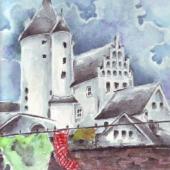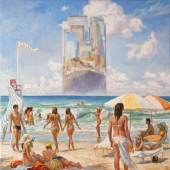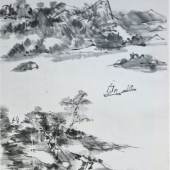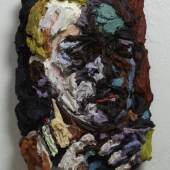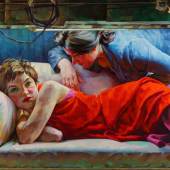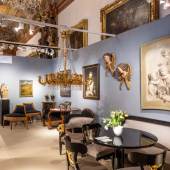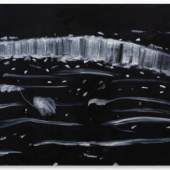Alex Katz The Venice Paintings
-
Ausstellung15.02.2025 - 12.04.2025
I am trying to make paintings that have some real energy – the here and now. It’s like fashion, really. — Alex Katz
Following Alex Katz’s landmark show at the Fondazione Giorgio Cini during the 60th Venice Biennale in 2024, this exhibition at Thaddaeus Ropac Paris Pantin reunites, for the first time, the works shown together in the City of Water. Spanning three major groupings of work made between 2021 and 2022, the paintings on view represent three key facets of the artist’s practice, the boundaries of which continue to expand seven decades into his career. A group of works based on outfits by mid-century American fashion designer Claire McCardell is accompanied by large-scale close-up depictions of inky-hued oceans, and of grassland in tones of greens and yellows.
Through the late 1980s and 1990s, Katz focused much of his attention on large-scale landscape paintings, which he characterises as ‘environmental’, the evolution of which can be seen in the closely cropped, all-encompassing landscapes and waterscapes on view in the exhibition. As the artist says of these paintings: ‘The close-up gives the painting much more power and energy. With the close-ups, I could make a realistic painting that could compete with a de Kooning or a Pollock.’ It was not until the 2010s that he began painting multiple tightly cropped portraits sequenced across the canvas as if in a strip of film, combining a variety of angles to create the impression of an ‘environmental’ portrait. He has renewed this cinematic compositional logic by applying it to Claire McCardell’s celebrated designs, which are represented in the collections of the Victoria and Albert Museum, London, The Metropolitan Museum of Art, New York, and the Los Angeles County Museum of Art.
Katz has long been interested in fashion design, particularly as it relates to the American vernacular tradition: as early as 1960, he paid homage to the iconic ‘little black dress’ that marked 20th-century fashion in his renowned The Black Dress (Museum Brandhorst, Munich). In the 1980s, his admiration for the work of American designer Norma Kamali, who was herself influenced by McCardell, resulted in the well-known paintings Pas De Deux (1983; Colby College Museum of Art, Maine) and Eleuthera (1984). In a recent interview, Katz described Claire McCardell’s designs as ‘unaffected’: a quality that harmonises with his pared-back painterly style.
Several of the works on view feature bipartite or even tripartite compositions, with fragments of different outfits and models recalling the visual strategies of Cubism, while also emulating cinematic montage techniques. Katz has stated: ‘People see my paintings with eyes trained by seeing movies and photographs in magazines. I try to use the way these things alter the way people see as a key to the way I construct my paintings.’ As a visual device, the splits and crops also resonate with today’s digital framework, demonstrating Katz’s continued awareness of how society looks at images. ‘The temporal and stylistic permanence of Katz’s paintings confront and empathize with the fundamental and structural impermanence of fashion,’ writes curator Éric Troncy. In Katz’s words: ‘Fashion is ephemeral. Any symbol of that thing that is really new in fashion instantly becomes mortal.’
Katz has always defined himself as a painter of ‘the immediate present’, in his landscapes and waterscapes as much as in his portraits. It was with landscapes that Katz found his voice as a young painter, exploring the lakes and forests of Maine while a student at the Skowhegan School of Painting and Sculpture. There, he discovered the freedom that comes with working en plein air, like the Impressionists, painting quick oil sketches in nature which he then turned into large-scale environmental works in his studio. Cropped and painted larger than life, the paintings of grass on view in the exhibition lend the windswept blades a quiet but powerful beauty. Therein lies the power of Katz’s paintings: neither abstract nor realistic, they focus on a small, unmoored slice of life, allowing poetry and abstract thinking to arise from pure perception rather than narrative.
Though water had been a recurring element in Katz’s paintings during his early formative years, it wasn’t until his retrospective at the Whitney Museum of American Art, New York in 1986 that it became a subject in its own right. Starting in the 1980s with his ongoing Black Brook series, works from which are held by Tate, London, and the Fondation Louis Vuitton, Paris, Katz continued exploring the effects of light and reflection on the surface of water over the course of the decades that followed with works such as Dark Reflections (1995; Whitney Museum of American Art, New York) or Grey Marine (2000; Tate, London). The exhibition highlights this aspect of Katz’s practice with a group of oceanscapes, rendered in monochrome with expressive white brushstrokes landing on dark grounds to suggest waves breaking or moonlight catching on the surface of a fathomless sea.
-
27.07.2021 - 31.07.2021Mit dem GALLERY WEEK_END 2021 erhält die Kulturszene Salzburgs ein neues Veranstaltungs-format,...
-
23.03.2024 - 01.04.2024Die Messe für Kunst, Antiquitäten und Design gehört zum österlichen Salzburg wie die Palmbuschen...
-
14.10.2022 - 16.10.2022Im Messezentrum Salzburg laufen die Aufbauarbeiten für die 18. Auflage der Internationalen...
-
Die römischen Künstlerkollegen, die von Michelangelo und vom Manierismus geprägt...
-
15.02.2025 - 12.04.2025I am trying to make paintings that have some real energy – the here and now. It’s...
-
01.03.2025 - 19.04.2025Oliver Beer präsentiert seine Resonance Paintings: The Cave erstmals in der Galerie Thaddaeus...
-
15.02.2025 - 12.04.2025
Tuesday—Saturday, 10am—6pm.

